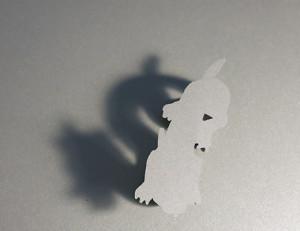These days, it seems like there’s almost nothing you can’t 3D print with. There’s electrically conductive filament, magnetic filament, filament that glows, shimmers, or smells nice. There’s a whole world of fancy filaments and magical metals, but Sculpteo has just announced a new type of material that may overshadow them all. No one saw this material coming, and it’s likely that no one will – literally, as in, you won’t see the 3D printed object thrown at your head, because it’s invisible. That’s right, Sculpteo’s team of magicians has done the seemingly impossible and developed an invisible printing material – plus a brand new method of 3D printing.
“With the additive manufacturing technique SLS, your object will be composed of thin layers which are almost invisible to the naked eye unlike FDM,” Sculpteo explains. “Through the hard work of our engineers during those long winter months in a room where the temperature rarely exceeded 50°F, we finally found a way to have the perfect object. We realized that the powder used in the SLS process generates a thickness that could be reduced to some extent. The limiting factor of this process is the size of the powder particle. So we removed the powder and we have created air laser sintering (ALS)!”
The process is similar to SLS, which uses a laser to sinter together layers of powder material. After each round of sintering, the print bed is lowered and another layer of powder is swept across the top. It’s the same with ALS, except that layers of air are swept over each other as the print bed is lowered. Sculpteo is being a bit cryptic as to how, exactly, these layers of air are sintered together, but they’ve hinted that it has something to do with UFOs.
So…why would you want to print anything with invisible filament? Why wouldn’t you, I ask. Just think of the pranking possibilities for this material, oh-so-conveniently introduced on April Fools’ Day. There are the unseen objects you can throw at people, as described above, and as an added convenience, Sculpteo points out, the negligible amount of raw material involved in an invisible print makes it incredibly inexpensive. Invisible 3D printed projectiles? Cheap. Messing with people’s heads? Priceless.
At this point, it doesn’t appear as though the invisible material can transfer its powers of invisibility, so, sadly, invisibility cloaks still aren’t a thing. That we know of. But the material’s perks by far overshadow its limitations, in my opinion. According to Sculpteo, it prints in seconds, it’s food safe, and extremely flexible and durable. Caution is advised when trying to glue multiple parts together, as it’s obviously a bit of a challenge to assemble things you can’t see; rumor has it that even Sculpteo’s finest engineers ended up gluing their fingers together during research and development.
“Parts printed in invisible being designed from one of the four elements that is air, are resistant to water, fire and earth relatively speaking,” the Sculpteo team states. “The invisible material can not resist a single concept: imagination. Give an invisible object to someone who lacks imagination and your item will be reduced to nothingness. Because of their invisibility, please mark their presence by a label when you set them on a table to easily find them.”
Have a happy April Fools’ Day, dear readers, and watch out for any invisible banana peels someone may have left lying around. Discuss in the Invisible 3D Printing Material forum over at 3DPB.com.
Subscribe to Our Email Newsletter
Stay up-to-date on all the latest news from the 3D printing industry and receive information and offers from third party vendors.
You May Also Like
Precision at the Microscale: UK Researchers Advance Medical Devices with BMF’s 3D Printing Tech
University of Nottingham researchers are using Boston Micro Fabrication‘s (BMF) 3D printing technology to develop medical devices that improve compatibility with human tissue. Funded by a UK grant, this project...
3D Printing Webinar and Event Roundup: April 21, 2024
It’s another busy week of webinars and events, starting with Hannover Messe in Germany and continuing with Metalcasting Congress, Chinaplas, TechBlick’s Innovation Festival, and more. Stratasys continues its advanced training...
3D Printing Webinar and Event Roundup: March 17, 2024
It’s another busy week of webinars and events, including SALMED 2024 and AM Forum in Berlin. Stratasys continues its in-person training and is offering two webinars, ASTM is holding a...
3D Printed Micro Antenna is 15% Smaller and 6X Lighter
Horizon Microtechnologies has achieved success in creating a high-frequency D-Band horn antenna through micro 3D printing. However, this achievement did not rely solely on 3D printing; it involved a combination...

































